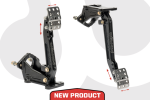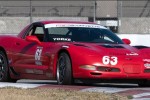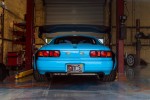
Remember the good old days when car audio manufacturers produced products that actually outperformed their published specs? Well, if you are talking about the Phoenix Gold Ti2 amplifier, those days are back. These amps are designed and built to the same competition-level standards that made the Phoenix Gold brand legendary in the good old days. Talk is cheap you say? To prove their claim of underrated performance and excellent quality, Phoenix Gold sent us one of their new Ti2 800.1 monoblock amps and told us to run it through our tests. Here’s what we found…
Features
The Ti2 800.1 is a Class-D amplifier designed specifically to drive subwoofer loads down to one ohms. The amp is rated at 600 watts into two ohms, and 800 watts into one ohms. It’s quite small for the power it develops, measuring approximately 11.7x7x2 inches. An extruded aluminum chassis is finished in classy satin black powder coat, with the logo and model number screened in gloss black for a ‘tone on tone’ appearance. The top center of the amplifier uses a dark smoked Plexiglas cover, with the trademark blue LED triangle in the center. Just below that, a clip indicator is provided to show when you’re overdoing things.
The layout is straightforward, with power and speaker connectors on one end and audio signal connections and controls on the other. Here, you’ll find adjustable pots for gain, crossover, subsonic filter, variable phase and bass EQ. The low-pass crossover is adjustable from 30 to 200 Hz, with a -24 dB/oct slope. The subsonic filter is unusual in that it has double the slope, at -48 dB/oct, which provides excellent protection for your expensive woofers. The subsonic filter has an adjustment range of between 10 and 55 Hz. Additionally, the crossover and subsonic filter pots have 41 individual detents and the frequency of each position is highlighted in the manual, so the user simply counts the clicks, allowing very precise adjustments. The variable phase control provides 198 degrees of adjustment at 100 Hz, while the bass EQ can be set for up to 18 dB of boost at 45 Hz.
Adjacent to the tuning controls are two ports: an RJ45 for connecting the wired level control and clipping indicator, and an RJ11 port for Phoenix Gold’s RMD (Remote Mountable Amplifier Voltage Display).
Looking inside, the Ti2 800.1 reveals a well made product, with top quality parts, and the latest in surface-mount technology. The PCB is military-spec FR4 and in keeping with Phoenix Gold tradition, has a slogan printed on it. This one says, ”To be the man, you have to beat the man.” I was curious, so I Googled the phrase. Evidently the WWE is everywhere.
Listening
For my listening session, I connect the Ti2 800.1 to my reference system and use it to drive a pair of two ohms, 10-inch woofers in a sealed enclosure. After getting the initial adjustments dialed in (subsonic to 10 Hz, crossover at 100 Hz, phase at 0 degrees and no added bass EQ) I sit down and listen to it.
Maybe because this amp is a throwback to days past, but something induced a Freudian slip, so I break out a seldom (but favorite) disc to evaluate the woofer amplifier. The disc is a Telarc recording of a band called Papa Doo Run Run, who performed predominately ‘surf music’ in the 1960s. The disc is called California Project, and somehow still available. The recording is as usual from Telarc – simply brilliant. The Surfin’ USA track has possibly the best recorded kick drum in history. Immediately I am impressed by the power and relative ease that the smallish amp drives my woofer system. Not only do I have more than enough power, the bottom end is well-controlled and musical. Next up is another old but fantastic recording, Don Dorsey on the pipe organ playing Bach’s Toccata in D Minor. Wow. When you have exemplary recordings it becomes much easier to nit-pick the performance of audio gear. But not this time… the Ti2 800.1 is more than up to the task, and I note not a single negative comment on my listening sheet in my two hour session.
On the Bench
Thoroughly enjoying my listening session, I move to the deadly-accurate Cogent test bench to see just how much over spec the amp actually was. I begin with power measurements and sure enough, the Ti2 800.1 easily developed well over its rated power at any impedance, topping 1,200 watts into one ohms. Even more impressive (and without tightly regulating the power supply), the amp even exceeded its rated power at lower impedances when the battery voltage is reduced to 12.6 volts! Efficiency is good and the controls operate exactly as advertised. The only spec that is average is the signal-to-noise ratio, but this is a fairly inconsequential specification on a subwoofer amplifier.
Conclusion
If you ever find yourself longing for the good old days and getting what you paid for and then some, there are few amplifiers that match the value of the Phoenix Gold Ti Series. With impressive power and control, small size and excellent adjustability, the Ti2 800.1 proves it’s easily worth the $499.99 U.S. retail price.
Technical Data
The following power measurements were obtained using industry standard methods. (1 kHZ @ 1.0 % THD+N - Battery voltages shown +/- 0.2 V)
Measured Performance Specifications
Manufacturers Rated Power Actual Measured Power
@ 1.0 % THD+N @ 12.6 V Battery Actual Measured Power
@ 1.0 % THD+N @ 14.4 V Battery
400 x 1 @ 4 Ohms 380 x 1 @ 4 Ohms 496 x 1 @ 4 Ohms
600 x 1 @ 2 Ohms 641 x 1 @ 2 Ohms 847 x 1 @ 2 Ohms
800 x 1 @ 1 Ohms 920 x 1 @ 1 Ohms 1230 x 1 @ 1 Ohms
Signal to Noise Ratio referenced to 2 V output.
(CEA-2006A) (1 watt @ 4 ohms) -65.7 dBA
Signal to Noise Ratio referenced to full output. -92.7 dBA
THD+N at rated power 0.13 %
Maximum Efficiency at full 2 ohms power per ch. 86.3 %
Idle Current 0.9 A
Input Sensitivity 196 mV- 9.3 V
Maximum Current @ full power, lowest rated impedance 112.5 A
Frequency Response (-3 dB) 10 Hz – 205 Hz
High Pass Crossover (Subsonic Filter) 10 Hz – 55 Hz -48 dB/oct
Low Pass Crossover 34 Hz – 200 Hz -24 dB/oct
Bass EQ boost +19 dB @ 44 Hz
Phase Adjustment (degrees of shift @ 100 Hz) 198°
Related Articles
 Wildwood Releases Single Pedal Assemblies for Tandem Master Cylinders
Wildwood Releases Single Pedal Assemblies for Tandem Master Cylinders
 All Weather vs All Season Tires: Toyo Celsius II Unboxed
All Weather vs All Season Tires: Toyo Celsius II Unboxed
 PASMAG's 25th Anniversary: Celebrating with Expanded Tuning365 Tour @ Formula Drift Events and PAS365 Rally Series
PASMAG's 25th Anniversary: Celebrating with Expanded Tuning365 Tour @ Formula Drift Events and PAS365 Rally Series
 Wilwood Announces Wilwood Corvette Challenge + Speed Ventures Partnership 2024
Wilwood Announces Wilwood Corvette Challenge + Speed Ventures Partnership 2024
 Whiteline Expands Suspension Upgrades for EVs
Whiteline Expands Suspension Upgrades for EVs
 Still Got It: A V6-Swapped MR2 Too Special To Relinquish
Still Got It: A V6-Swapped MR2 Too Special To Relinquish








